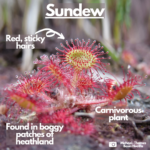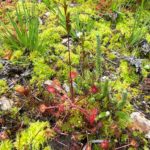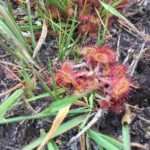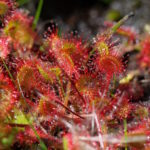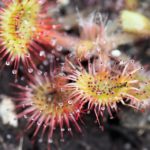Sundew

Back Cross-leaved Heath Common Heather Bell Heather Common Gorse Dwarf Gorse Sundew
ROUND-LEAVED SUNDEW
Drosera rotundifolia
A very unusual plant with carnivorous tastes. Sundews lure insects in with sweet, sticky excretions at the tips of their adapted leaves. The leaves curl around an entrapped victim and the plant begins to remove valuable nutrients from its prey.
The hair-covered leaves are a green-red colour and are arranged in a rosette pattern at the bottom of the plant. In the summer, white and pink flowers sprout from the tops of its red stems. Not to be confused with the similar oblong-leaved sundew, its leaves are much more rounded.
- Bog plants including sphagnum moss and carnivorous sundew
- Did you know we have insect-eating plants on the heaths? This is a sundew, a carnivorous plant seen on Flo’s walk at Sheets Heath.
- Sundew, a carnivore of the heaths! Photographed by Gary Attfield.
- Sundew by Martin D’Arcy
[Click on the thumbnails to open]
Where/when to find it
During summer, Sundew’s red-pink leaves can be seen on peaty moors, wet lowland heath and margins of bog pools amongst damp sphagnum mosses. These plants are very small, so you will have to look carefully along the edges of damp tracks to find them.
Adaptations
The acidic habitats in which the Sundew lives are generally nutrient poor, so the plant has evolved an ability to trap and digest insect prey to supplement its diet.
Rarity
Found on the Thames Basin Heaths, but not especially common in south and east England. Found more widely in the north and west.
Read more
On Plant Life’s website: Round-leaved Sundew
#MoreThanJustNightjars

